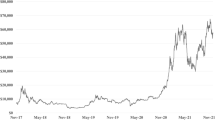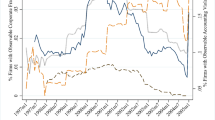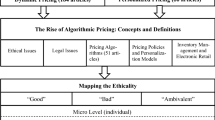Abstract
This paper studies the impact of adopting a monitoring system on counterfeiting, in which a criterion to minimize welfare losses due to counterfeiting is provided. If the degree to which the genuine product is imitated (hence the imitation rate) is not high, then counterfeit products might be allowed to exist in such a market. For the case of a high imitation rate, the use of a counterfeit monitoring regime with an optimal counterfeit-monitoring rate is the best policy. If the duration of intellectual property protection is set as infinite, then a higher monitoring rate corresponds to a narrower protection scope. Finally, the enforcement of the laws of intellectual property rights should be flexible according to a product’s inherent attributes as pertaining to the difficulties at imitating the original products.
Similar content being viewed by others
References
Aghion, P., Harris, C., Howitt, P., & Vickers, J. (2001). “Competition, Imitation and Growth with Step-by-Step Innovation.” Review of Economic Studies. {68}, 467–492.
Banerjee, D. S. (2003). “Software Piracy:, A Strategic Analysis and Policy Instruments.” International Journal of Industrial Organization. 21, 97–127.
Besen, S. M. & Kirby, S. N. (1989). “Private Copying, Appropriability, and Optimal Copy Royalties.” Journal of Law and Economics. 32, 255–280.
Choi, J. C. & Shin, H. S. (1992). “A Comment on a Model of Vertical Product Differentiation.” The Journal of Industrial Economics. 60, 229–231.
Conner, K. R. & Rumelt, R. P. (1991). “Software Piracy:, An Analysis of Protection Strategies.” Management Science. 37, 125–139.
Geroski, P. (1995). “Markets for Technology: Knowledge, Innovation and Appropriability.” In, P. Stoneman (ed.), Handbook of the Economics of Innovation and Technological Change. Oxford: Blackwell.
Gilbert, R. & Shapiro, C. (1990). “Optimal Patent Length and Breadth.” Rand Journal of Economics. 21, 106–112.
Gordon, W. J. & Bone, R. G. (2000). “Copyright.” In, B. Bouckaert & G. De Geest, (eds.), Encyclopedia of Law and Economics. Northampton, MA: Edward Elgar, Vol. 2.
Griliches, Z. (1990). “Patent Statistics as Economic Indicators: A Survey.” Journal of Economic Literature. 28, 1661–1707.
Grossman, G. M. & Shapiro, C. (1988a). “Counterfeit-Product Trade.” American Economic Review. 78, 59–75.
Grossman, G. M. & Shapiro, C. (1988b). “Foreign Counterfeiting of Status Goods.” The Quarterly Journal of Economics. 103, 79–100.
Higgins, R. S. & Rubin, P. H. (1986). “Counterfeit Goods.” The Journal of Law and Economics. 29, 211–230.
Johnson, W. R. (1985). “The Economics of Copying.” Journal of Political Economy. 93, 158–174.
Klemperer, P. (1990). “How Broad Should the Scope of Patent Protection Be?” Rand Journal of Economics. 21, 113–130.
Liebowitz, S. J. (1985). “Copying and Indirect Appropriability: Photocopying of Journals.” Journal of Political Economy. 93, 945–957.
Motta, M. (1993). “Endogenous Quality Choice: Price vs. Quality Competition.” The Journal of Industrial Economics. 42(2), 113–131.
Mussa, M. & Rosen, S. (1978). “Monopoly and Product Quality.” Journal of Economic Theory. 18, 301–317.
Novos, I. E. & Waldman, M. (1984). “The Effects of Increased Copyright Protection: An Analytic Approach.” Journal of Political Economy. 92, 236–246.
Shy, O. & Thisse, J.-F. (1999). “A Strategic Approach to Software Protection.” Journal of Economics and Management Strategy. 8, 163–190.
Takeyama, L. N. (1994). “The Welfare Implications of Unauthorized Reproduction of Intellectual Property in the Presence of Demand Network Externalities.” Journal of Industrial Economics. 42, 155–166.
Time Magazine (2001a). “Chasing Shadows,” June 11.
Time Magazine (2001b). “In Defense of Fakes,” June 11.
Tirole, J. (1988). The Theory of Industrial Organization. Cambridge, MA: MIT Press.
Author information
Authors and Affiliations
Corresponding author
Additional information
JEL Classification: D42, K42, L43
Rights and permissions
About this article
Cite this article
Yao, JT. Counterfeiting and an Optimal Monitoring Policy. Eur J Law Econ 19, 95–114 (2005). https://doi.org/10.1007/s10657-005-5277-2
Issue Date:
DOI: https://doi.org/10.1007/s10657-005-5277-2




